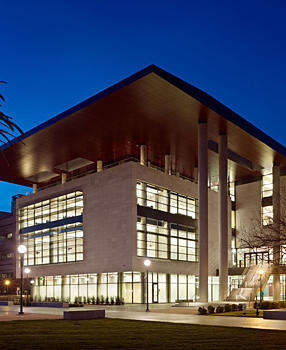
In Brief
Building boom
New Classrooms, study space and futuristic technology — plus the biggest stem cell research facility in the nation
Photo by Bruce Damonte
The Li Ka Shing Center for Learning and Knowledge: the new home for classrooms and training facilities.
2010 is one for the School of Medicine’s record books, with the opening of the most new building space in a single year in the school’s history.
Dedication ceremonies took place in late September for the 120,000-square-foot Li Ka Shing Center for Learning and Knowledge, followed one month later by the opening of the Lorry I. Lokey Stem Cell Research Building, at 200,000 square feet. By comparison, when the school first moved from San Francisco to Palo Alto in 1959, the buildings in use that first year (Alway, Lane and Edwards) totaled 268,000 square feet, according to the school’s facilities office.
Together, the new buildings embody the school’s goals of transforming both education and stem cell research, and making discoveries and innovations that will improve the future of health care.
The Center for Learning and Knowledge is the school’s new “front door” and home to its classrooms and training facilities. The five-story structure has a diverse array of technologies that represent the latest in medical education. It is designed for interactive, experiential and team-based approaches to learning for people at all levels, from incoming medical students to experienced clinicians who want to polish their skills.
David Gaba, MD, associate dean for immersive and simulation-based learning, says the building’s simulation center is one of the largest and most comprehensive facilities of its kind.
“We will never entirely replace the apprenticeship model, where you learn based on the idea, ‘See one, do one, teach one,’” Gaba says. “But there is a lot we can do in simulation that fills the gap in the traditional system of learning,” where trainees treat only those patients who come through the door and may not be exposed to the full range of medical problems.
The nearby Lokey building will be the nation’s largest stem cell research facility, with 33 research labs comprising 528 research benches. Scientists in the four-story building — which features a dramatic glass sculpture by artist Dale Chihuly — will be involved in the full spectrum of stem cell programs, including research in embryonic and adult stem cells, cancer stem cells and the development of disease-specific stem cell lines. They represent disciplines that include neurology, cancer, transplantation, immunology, cardiology, developmental biology and bioengineering.
“What is important is that it will give people the opportunity to apply stem cell thinking to different problems, including regeneration, aging and cancer,” says Irving Weissman, MD, director of the Stanford Institute for Stem Cell Biology and Regenerative Medicine, which is housed in the new building.
The new facilities were financed with a mix of philanthropy and school funds and, in the case of the Lokey building, a grant from the California Institute for Regenerative Medicine. Looking further into the future, the school’s construction plans include the 2012 completion of the Jill and John Freidenrich Center for Translational Research, at 800 Welch Road; new buildings that will house the school’s cardiovascular, neuroscience, cancer and immunity/transplantation/infection institutes; and the eventual demolition of the Alway, Lane, Edwards and Grant buildings to make way for three new research facilities.— Susan Ipaktchian


